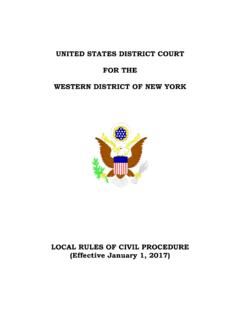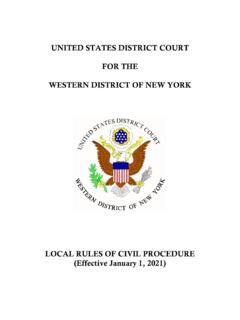Transcription of INSTRUCTIONS FOR PREPARING A MOTION IN A CIVIL ACTION
1 Revised 04/13 FOR PREPARING A MOTION IN A CIVIL ACTIONC heck the Western District s web site at for copies of many of the Court s forms and other useful " MOTION " is the means by which a party to a lawsuit requests the judge to take some specific ACTION in the case. A MOTION can be brought to ask the Court to order any of the kinds of relief described in the Federal Rules of CivilProcedure, or to ask the Court to order a party to take any other ACTION required by law, or to ask the Court to takesome ACTION itself. The Federal Rules of CIVIL Procedure describe many of the purposes for which a MOTION can be used. (See, ,Rules 7, 11, 12, 37, 50 and 56). However, a MOTION can be employed to ask the Court to do other things as well. The most common type of MOTION in pro se cases which is not included in the above list is a MOTION forAppointment of Counsel pursuant to 28 INSTRUCTIONS and attached examples are designed to assist you in PREPARING your MOTION in the proper form;they are not intended to provide you with any information about the substantive relief you can request in variousmotions.
2 To learn about the kinds of relief you can request by MOTION , you should carefully review the Federal Rulesof CIVIL Procedure, review the substantive law under which you are bringing your lawsuit, review 28 1915,and familiarize yourself with the Western District of New York's Local Rules of CIVIL Procedure 5, 7, 26, 37, and56 (the Local Rules are available at on the Western District web site).1. FORM OF YOUR MOTION PAPERSA. Notice of MOTION (see Form A below)The proper form for MOTION papers requires you to present the Court with two or three separate documents whichall become part of your MOTION papers. The first document is a Notice of MOTION . The format for the Notice ofMotion is set out in Form A below. In the upper left-hand corner of your Notice of MOTION , copy the caption of your case as it appears on an official document (for example, on your Order granting you permission to proceed in forma pauperis).
3 In the upper right-hand corner, at the same height on the paper as the caption, write the docket number of your case (for example98-CV-0123C). Below the docket number write, "Notice of MOTION ."Beneath the caption your MOTION should say PLEASE TAKE NOTICE, that the undersigned will bring a motion_____. In the blank space, you should write the relief you want the Court to give you. For example, you mightsay, for an order appointing counsel to represent me or for an order compelling the defendants to respond toplaintiff's interrogatories (read Local Rules of CIVIL Procedure 37 first) or for an order compelling discoverypursuant to Federal Rules of CIVIL Procedure Rule 37; or for an order granting summary judgment (Read LocalRules of CIVIL Procedure and 56 first).
4 Sign your Notice of MOTION . The judge's courtroom deputy will schedule your MOTION according to the judge'scalendar and advise you of the date. Not all motions are scheduled for hearings; some are decided on the basis ofthe papers : If you are opposing a MOTION brought by another party, you do NOT need to file a notice of MOTION , butthe following papers, the affidavits (and/or affirmations) may be used for opposing a Affidavit in Support (see Form B below)The next part of your MOTION is the Affidavit in Support of your MOTION . The caption and index number on youraffidavit should be written out just as on the Notice of MOTION , but instead of writing "Notice of MOTION ," you shouldwrite "Affidavit in Support of MOTION " below the docket : These INSTRUCTIONS assume that you have access to a Notary Public, and can get your papers notarized.
5 Anaffidavit is a statement that a person swears is true before a Notary Public, and is witnessed by that Notary. If youdo not have access to a Notary Public, you may use an affirmation, instead. The difference between an Affidavitand an Affirmation is that in an affirmation, instead of a Notary's seal, the party who signs the affirmation mustinclude a short statement affirming that the statement is true. Your affidavit should briefly state the relief you want the Court to grant (in the first paragraph), and then shouldexplain in short numbered paragraphs the reasons you believe you are entitled to that relief. (For example, inmoving for Appointment of Counsel, you should describe why you believe that you are unable to continue the actionwithout legal assistance, you should explain to the Court why you believe your lawsuit has merit, and you shouldtell the Court what efforts you have made to secure counsel on your own.)
6 If you have exhibits which support yourposition, you should attach copies to the affidavit and state in the affidavit why/how the exhibit supports yourposition. You may also submit affidavits from other people also, if they are relevant to the relief you are seeking(or opposing) in your Memorandum of Law ln certain instances, if you believe it will assist the Court, you may wish to submit a Memorandum of Law in supportof your MOTION . You are not required to submit a Memorandum of Law with every MOTION , but such memorandaare usually necessary when you expect a legal dispute as to whether you are entitled to the relief you have requested. A Memorandum of Law should be captioned and titled as are the other MOTION papers. Like all papers submittedin federal court, it must be note that when submitting a MOTION for Summary Judgment, you should include both a Memorandum of Lawand a separate short and concise statement of the facts material to your case which you believe are not disputed byyour opponent.
7 (See Local Rules of CIVIL Procedure 56.) If you are opposing a MOTION for summary judgment, youmust also submit a Memorandum of Law and a Statement of Undisputed SERVICE OF YOUR MOTION PAPERS (see Form C(1) and Form C(2) below)You are required to serve a copy of any MOTION papers you file in your lawsuit on your opponents, or on their lawyerif they have one. The only exception to this rule is when you are filing a MOTION before your opponents haveanswered your complaint. In many cases, your MOTION will be addressed to the other party because you are tryingto get the Court to direct the other party to do something. However, even when you are simply asking the Court totake some ACTION on its own (such as appoint counsel), you must send a copy of your MOTION papers to must also advise the Court that you have served a copy of all of your MOTION papers on your opponents byenclosing with the MOTION papers an Affirmation or Affidavit of Service (see Forms C(1) and C(2) below).
8 Likethe Affidavit/Affirmation in Support of your MOTION , an affidavit of service is signed and notarized and anaffirmation of service is signed under penalty of perjury. Do not complete your affidavit of service until after you have prepared the copies of your MOTION papers forall other parties and either mailed them or hand-delivered them to those TECHNICALITIESYou must file original papers with the Clerk of the Court. The requirement that you file original papers has beeninterpreted to mean that the signature on the papers must be original. If you have access to photocopying, youcan make several copies of your MOTION without signatures, and sign them all before you mail them. If you sign allof your papers before photocopying them, make sure to send the one with the original signature to the Court.
9 If youuse carbon paper, you must make sure that the Court receives a copy (or the original) that has an original signatureon attached exhibits may be and often should be copies of the original you do not have access to photocopying or carbon paper, you may write out several hand-written copies of yourmotion. Make sure that every copy is exactly the same as every other a copy of your MOTION with an original signature to the Clerk's office in the city where the judge who is hearingyour case is located. In rochester : Judges Geracie, Larimer, Siragusa and Telesca, and Magistrate Judges Feldman and Payson arelocated in rochester ; address your MOTION papers to: Clerk's Office, United States District Court, 2120 , 100 State Street, rochester New York 14614. (Phone: (585) 263-6263.)
10 In Buffalo: Chief Judge Skretny and Judges Arcara, and Curtin, and Magistrate Judges Foschio, Scott, Schroeder,and McCarthy are located in Buffalo; address your papers to: Clerk's Office, United States District Court, 200 , 2 Niagara Square, Buffalo New York 14202-3498. (Phone: (716) 551-1500 or (716) 551-1700.)Do not send your MOTION papers directly to the judge's chamber. The MOTION must be recorded in the official recordof your case (the docket sheet) by the Clerk's office before the judge takes any ACTION on it. If you mail your papersdirectly to the judge, you will only delay the time it takes for your papers to be considered. Do not send extra copiesof your papers to the judge. Sending extra copies of your MOTION papers only creates confusion, and will cause youunneeded expense and be assured that every MOTION that is mailed to the Clerk's office is entered in the docket sheet of your caseand given to the judge for consideration.



